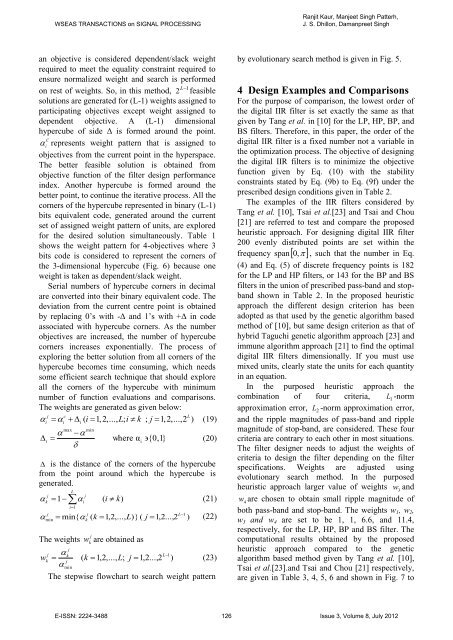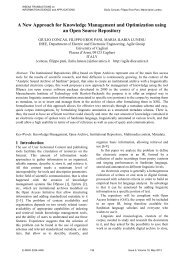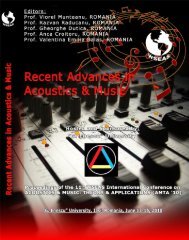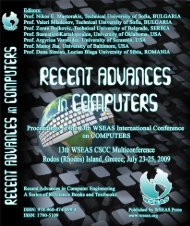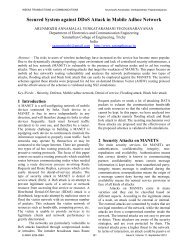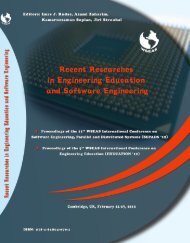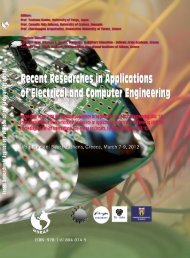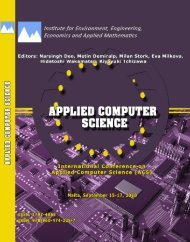Heuristic Search Method for Digital IIR Filter Design - WSEAS
Heuristic Search Method for Digital IIR Filter Design - WSEAS
Heuristic Search Method for Digital IIR Filter Design - WSEAS
You also want an ePaper? Increase the reach of your titles
YUMPU automatically turns print PDFs into web optimized ePapers that Google loves.
<strong>WSEAS</strong> TRANSACTIONS on SIGNAL PROCESSING<br />
Ranjit Kaur, Manjeet Singh Patterh,<br />
J. S. Dhillon, Damanpreet Singh<br />
an objective is considered dependent/slack weight<br />
required to meet the equality constraint required to<br />
ensure normalized weight and search is per<strong>for</strong>med<br />
on rest of weights. So, in this method, 2 L1<br />
feasible<br />
solutions are generated <strong>for</strong> (L-1) weights assigned to<br />
participating objectives except weight assigned to<br />
dependent objective. A (L-1) dimensional<br />
hypercube of side Δ is <strong>for</strong>med around the point.<br />
represents weight pattern that is assigned to<br />
C<br />
i<br />
objectives from the current point in the hyperspace.<br />
The better feasible solution is obtained from<br />
objective function of the filter design per<strong>for</strong>mance<br />
index. Another hypercube is <strong>for</strong>med around the<br />
better point, to continue the iterative process. All the<br />
corners of the hypercube represented in binary (L-1)<br />
bits equivalent code, generated around the current<br />
set of assigned weight pattern of units, are explored<br />
<strong>for</strong> the desired solution simultaneously. Table 1<br />
shows the weight pattern <strong>for</strong> 4-objectives where 3<br />
bits code is considered to represent the corners of<br />
the 3-dimensional hypercube (Fig. 6) because one<br />
weight is taken as dependent/slack weight.<br />
Serial numbers of hypercube corners in decimal<br />
are converted into their binary equivalent code. The<br />
deviation from the current centre point is obtained<br />
by replacing 0’s with -Δ and 1’s with +Δ in code<br />
associated with hypercube corners. As the number<br />
objectives are increased, the number of hypercube<br />
corners increases exponentially. The process of<br />
exploring the better solution from all corners of the<br />
hypercube becomes time consuming, which needs<br />
some efficient search technique that should explore<br />
all the corners of the hypercube with minimum<br />
number of function evaluations and comparisons.<br />
The weights are generated as given below:<br />
j c<br />
L<br />
( i 1,2,...,<br />
L;<br />
i k ; j 1,2,...,2<br />
) (19)<br />
i<br />
i<br />
i<br />
max min<br />
<br />
i <br />
where α i<br />
{0,1}<br />
(20)<br />
<br />
is the distance of the corners of the hypercube<br />
from the point around which the hypercube is<br />
generated.<br />
L<br />
j<br />
j<br />
1<br />
( i k)<br />
(21)<br />
k<br />
<br />
i1<br />
i<br />
j<br />
j<br />
L1<br />
min{ ( k 1,2,...,<br />
L)} ( j 1,2...,2<br />
) (22)<br />
min<br />
The weights<br />
w<br />
j<br />
k<br />
<br />
<br />
<br />
j<br />
k<br />
j<br />
min<br />
k<br />
j<br />
wk<br />
are obtained as<br />
L<br />
( k 1,2,...,<br />
L;<br />
j 1,2...,2<br />
1<br />
)<br />
(23)<br />
The stepwise flowchart to search weight pattern<br />
by evolutionary search method is given in Fig. 5.<br />
4 <strong>Design</strong> Examples and Comparisons<br />
For the purpose of comparison, the lowest order of<br />
the digital <strong>IIR</strong> filter is set exactly the same as that<br />
given by Tang et al. in [10] <strong>for</strong> the LP, HP, BP, and<br />
BS filters. There<strong>for</strong>e, in this paper, the order of the<br />
digital <strong>IIR</strong> filter is a fixed number not a variable in<br />
the optimization process. The objective of designing<br />
the digital <strong>IIR</strong> filters is to minimize the objective<br />
function given by Eq. (10) with the stability<br />
constraints stated by Eq. (9b) to Eq. (9f) under the<br />
prescribed design conditions given in Table 2.<br />
The examples of the <strong>IIR</strong> filters considered by<br />
Tang et al. [10], Tsai et al.[23] and Tsai and Chou<br />
[21] are referred to test and compare the proposed<br />
heuristic approach. For designing digital <strong>IIR</strong> filter<br />
200 evenly distributed points are set within the<br />
frequency span0 , , such that the number in Eq.<br />
(4) and Eq. (5) of discrete frequency points is 182<br />
<strong>for</strong> the LP and HP filters, or 143 <strong>for</strong> the BP and BS<br />
filters in the union of prescribed pass-band and stopband<br />
shown in Table 2. In the proposed heuristic<br />
approach the different design criterion has been<br />
adopted as that used by the genetic algorithm based<br />
method of [10], but same design criterion as that of<br />
hybrid Taguchi genetic algorithm approach [23] and<br />
immune algorithm approach [21] to find the optimal<br />
digital <strong>IIR</strong> filters dimensionally. If you must use<br />
mixed units, clearly state the units <strong>for</strong> each quantity<br />
in an equation.<br />
In the purposed heuristic approach the<br />
combination of four criteria, L1<br />
-norm<br />
approximation error, L2<br />
-norm approximation error,<br />
and the ripple magnitudes of pass-band and ripple<br />
magnitude of stop-band, are considered. These four<br />
criteria are contrary to each other in most situations.<br />
The filter designer needs to adjust the weights of<br />
criteria to design the filter depending on the filter<br />
specifications. Weights are adjusted using<br />
evolutionary search method. In the purposed<br />
heuristic approach larger value of weights w and<br />
3<br />
w4<br />
are chosen to obtain small ripple magnitude of<br />
both pass-band and stop-band. The weights w 1 , w 2 ,<br />
w 3 and w 4 are set to be 1, 1, 6.6, and 11.4,<br />
respectively, <strong>for</strong> the LP, HP, BP and BS filter. The<br />
computational results obtained by the proposed<br />
heuristic approach compared to the genetic<br />
algorithm based method given by Tang et al. [10],<br />
Tsai et al.[23].and Tsai and Chou [21] respectively,<br />
are given in Table 3, 4, 5, 6 and shown in Fig. 7 to<br />
E-ISSN: 2224-3488 126 Issue 3, Volume 8, July 2012


